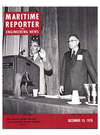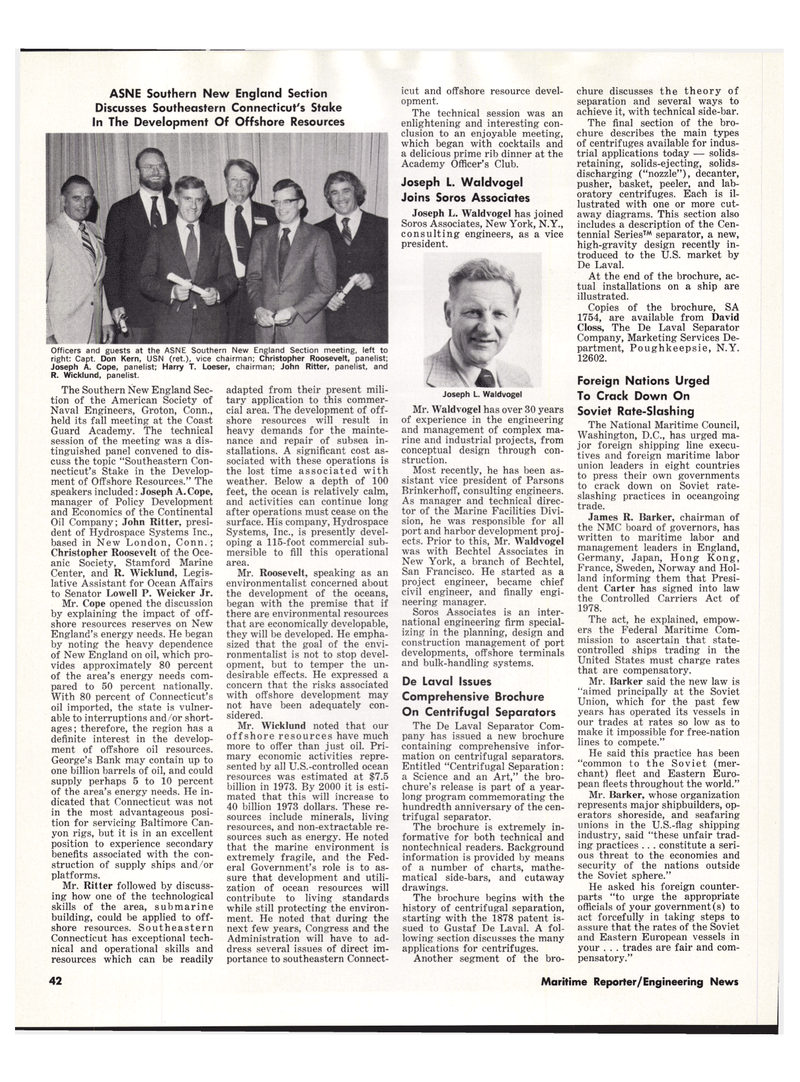
Page 46: of Maritime Reporter Magazine (December 15, 1978)
Read this page in Pdf, Flash or Html5 edition of December 15, 1978 Maritime Reporter Magazine
ASNE Southern New England Section
Discusses Southeastern Connecticut's Stake
In The Development Of Offshore Resources
Officers and guests at the ASNE Southern New England Section meeting, left to right: Capt. Don Kern, USN (ret.), vice chairman; Christopher Roosevelt, panelist;
Joseph A. Cope, panelist; Harry T. Loeser, chairman; John Ritter, panelist, and
R. Wicklund, panelist.
The Southern New England Sec- tion of the American Society of
Naval Engineers, Groton, Conn., held its fall meeting at the Coast
Guard Academy. The technical session of the meeting was a dis- tinguished panel convened to dis- cuss the topic "Southeastern Con- necticut's Stake in the Develop- ment of Offshore Resources." The speakers included: Joseph A.Cope, manager of Policy Development and Economics of the Continental
Oil Company; John Ritter, presi- dent of Hydrospace Systems Inc., based in New London, Conn. ;
Christopher Roosevelt of the Oce- anic Society, Stamford Marine
Center, and R. Wicklund, Legis- lative Assistant for Ocean Affairs to Senator Lowell P. Weicker Jr.
Mr. Cope opened the discussion by explaining the impact of off- shore resources reserves on New
England's energy needs. He began by noting the heavy dependence of New England on oil, which pro- vides approximately 80 percent of the area's energy needs com- pared to 50 percent nationally.
With 80 percent of Connecticut's oil imported, the state is vulner- able to interruptions and/or short- ages; therefore, the region has a definite interest in the develop- ment of offshore oil resources.
George's Bank may contain up to one billion barrels of oil, and could supply perhaps 5 to 10 percent of the area's energy needs. He in- dicated that Connecticut was not in the most advantageous posi- tion for servicing Baltimore Can- yon rigs, but it is in an excellent position to experience secondary benefits associated with the con- struction of supply ships and/or platforms.
Mr. Ritter followed by discuss- ing how one of the technological skills of the area, submarine building, could be applied to off- shore resources. Southeastern
Connecticut has exceptional tech- nical and operational skills and resources which can be readily adapted from their present mili- tary application to this commer- cial area. The development of off- shore resources will result in heavy demands for the mainte- nance and repair of subsea in- stallations. A significant cost as- sociated with these operations is the lost time associated with weather. Below a depth of 100 feet, the ocean is relatively calm, and activities can continue long after operations must cease on the surface. His company, Hydrospace
Systems, Inc., is presently devel- oping a 115-foot commercial sub- mersible to fill this operational area.
Mr. Roosevelt, speaking as an environmentalist concerned about the development of the oceans, began with the premise that if there are environmental resources that are economically developable, they will be developed. He empha- sized that the goal of the envi- ronmentalist is not to stop devel- opment, but to temper the un- desirable effects. He expressed a concern that the risks associated with offshore development may not have been adequately con- sidered.
Mr. Wicklund noted that our offshore resources have much more to offer than just oil. Pri- mary economic activities repre- sented by all U.S.-controlled ocean resources was estimated at $7.5 billion in 1973. By 2000 it is esti- mated that this will increase to 40 billion 1973 dollars. These re- sources include minerals, living resources, and non-extractable re- sources such as energy. He noted that the marine environment is extremely fragile, and the Fed- eral Government's role is to as- sure that development and utili- zation of ocean resources will contribute to living standards while still protecting the environ- ment. He noted that during the next few years, Congress and the
Administration will have to ad- dress several issues of direct im- portance to southeastern Connect- icut and offshore resource devel- opment.
The technical session was an enlightening and interesting con- clusion to an enjoyable meeting, which began with cocktails and a delicious prime rib dinner at the
Academy Officer's Club.
Joseph L. Waldvogel
Joins Soros Associates
Joseph L. Waldvogel has joined
Soros Associates, New York, N.Y., consulting engineers, as a vice president.
Joseph L. Waldvogel
Mr. Waldvogel has over 30 years of experience in the engineering and management of complex ma- rine and industrial projects, from conceptual design through con- struction.
Most recently, he has been as- sistant vice president of Parsons
Brinkerhoff, consulting engineers.
As manager and technical direc- tor of the Marine Facilities Divi- sion, he was responsible for all port and harbor development proj- ects. Prior to this, Mr. Waldvogel was with Bechtel Associates in
New York, a branch of Bechtel,
San Francisco. He started as a project engineer, became chief civil engineer, and finally engi- neering manager.
Soros Associates is an inter- national engineering firm special- izing in the planning, design and construction management of port developments, offshore terminals and bulk-handling systems.
De Laval Issues
Comprehensive Brochure
On Centrifugal Separators
The De Laval Separator Com- pany has issued a new brochure containing comprehensive infor- mation on centrifugal separators.
Entitled "Centrifugal Separation: a Science and an Art," the bro- chure's release is part of a year- long program commemorating the hundredth anniversary of the cen- trifugal separator.
The brochure is extremely in- formative for both technical and nontechnical readers. Background information is provided by means of a number of charts, mathe- matical side-bars, and cutaway drawings.
The brochure begins with the history of centrifugal separation, starting with the 1878 patent is- sued to Gustaf De Laval. A fol- lowing section discusses the many applications for centrifuges.
Another segment of the bro- chure discusses the theory of separation and several ways to achieve it, with technical side-bar.
The final section of the bro- chure describes the main types of centrifuges available for indus- trial applications today — solids- retaining, solids-ejecting, solids- discharging ("nozzle"), decanter, pusher, basket, peeler, and lab- oratory centrifuges. Each is il- lustrated with one or more cut- away diagrams. This section also includes a description of the Cen- tennial Series™ separator, a new, high-gravity design recently in- troduced to the U.S. market by
De Laval.
At the end of the brochure, ac- tual installations on a ship are illustrated.
Copies of the brochure, SA 1754, are available from David
Closs, The De Laval Separator
Company, Marketing Services De- partment, Poughkeepsie, N.Y. 12602.
Foreign Nations Urged
To Crack Down On
Soviet Rate-Slashing
The National Maritime Council,
Washington, D.C., has urged ma- jor foreign shipping line execu- tives and foreign maritime labor union leaders in eight countries to press their own governments to crack down on Soviet rate- slashing practices in oceangoing trade.
James R. Barker, chairman of the NMC board of governors, has written to maritime labor and management leaders in England,
Germany, Japan, Hong Kong,
France, Sweden, Norway and Hol- land informing them that Presi- dent Carter has signed into law the Controlled Carriers Act of 1978.
The act, he explained, empow- ers the Federal Maritime Com- mission to ascertain that state- controlled ships trading in the
United States must charge rates that are compensatory.
Mr. Barker said the new law is "aimed principally at the Soviet
Union, which for the past few years has operated its vessels in our trades at rates so low as to make it impossible for free-nation lines to compete."
He said this practice has been "common to the Soviet (mer- chant) fleet and Eastern Euro- pean fleets throughout the world."
Mr. Barker, whose organization represents major shipbuilders, op- erators shoreside, and seafaring unions in the U.S.-flag shipping industry, said "these unfair trad- ing practices . . . constitute a seri- ous threat to the economies and security of the nations outside the Soviet sphere."
He asked his foreign counter- parts "to urge the appropriate officials of your government (s) to act forcefully in taking steps to assure that the rates of the Soviet and Eastern European vessels in your . . . trades are fair and com- pensatory." reason to put our equipment to work for you. iiGnng<.niinoii6os2sUA». Maritime Reporter/Engineering News

 45
45

 47
47
